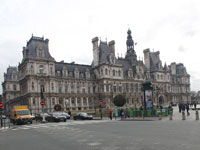 |
Although the current building dates from the 18th century, this site had been the center of municipal power since the 14th century. Andre Ayers explains the historical background: "The building we see today replaced an edifice whose construction was begun in 1533 by Pierre Chambiges to plans by the Italian architect Domenico da Cortona, and which had been extended by Hippolyte Godde and Jean-Baptiste Lesueur in the 1830s. One of the many real-estate casualties of the Communard uprising of 1871, the old town hall was burnt literally to a shell in a conflagration that lasted nearly a week. Although, miraculously, its walls were still standing after the disaster and could have served in the rebuilding, the authorities opted to demolish and start again from scratch. They did, however, stipulate that the original 16C frontispiece should be reproduced in the new edifice, thereby setting the historicist tone for the new design" (91-2). |


 Click here to return to index of art historical sites.
Click here to return to index of art historical sites.
 Click here to return to index of artists and architects.
Click here to return to index of artists and architects.
 Click here to return to chronological index.
Click here to return to chronological index.
 Click here to see the home page of Bluffton University.
Click here to see the home page of Bluffton University.

